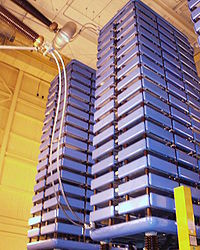
Valve hall
Encyclopedia

Electrical insulation
thumb|250px|[[Coaxial Cable]] with dielectric insulator supporting a central coreThis article refers to electrical insulation. For insulation of heat, see Thermal insulation...
s or hung from the roof of the valve hall. The latter required a stronger ceiling structure, however the hall and the static inverter can better survive earthquake
Earthquake
An earthquake is the result of a sudden release of energy in the Earth's crust that creates seismic waves. The seismicity, seismism or seismic activity of an area refers to the frequency, type and size of earthquakes experienced over a period of time...
s compared to valve structures standing on the floor.
A valve hall is equipped with heating and cooling equipment to control the temperature of the mercury arc rectifiers (which operate best over a narrow temperature range) or thyristors. The valve hall also protects the valves from weather and dust. Several valve assemblies, connected in series for the required terminal voltage, may be installed in the valve hall building.
High voltage bushings
Bushing (electrical)
A bushing is a hollow insulating liner through which a conductor may pass. Bushings appear on switchgear, transformers, circuit breakers and other high voltage equipment.- Description :...
are supported through the walls of the valve hall, to allow connections between the converter transformer
Transformer
A transformer is a device that transfers electrical energy from one circuit to another through inductively coupled conductors—the transformer's coils. A varying current in the first or primary winding creates a varying magnetic flux in the transformer's core and thus a varying magnetic field...
s on the one side and the DC switchyard on the other. Beside the valve hall there is often an additional building, in which are control electronics, equipment for valve cooling and valve monitoring, station service power distribution, and amenities for the plant workers.
Because very high voltages are present while the inverters are in operation, access to the valve halls is limited while the static inverter is running. The auxiliary control building may have windows to observe the valve hall, but usually the converter is remotely controlled. To protect communication systems from electromagnetic interference, valve hall buildings must have shielding installed to control emission of radio-frequency energy.
At some HVDC converters such as at Cabora-Bassa
Cabora-Bassa
Cabora-Bassa is the name for an HVDC power transmission system between the Cahora Bassa Hydroelectric Generation Station in Mozambique, and Johannesburg, South Africa. The bipolar HVDC power line was built between 1977 and 1979 and can transmit 1920 megawatts at a voltage level of...
, outdoor valves are installed in oil-immersed containers. At such exceptional plants no valve halls or wall bushings are required.

